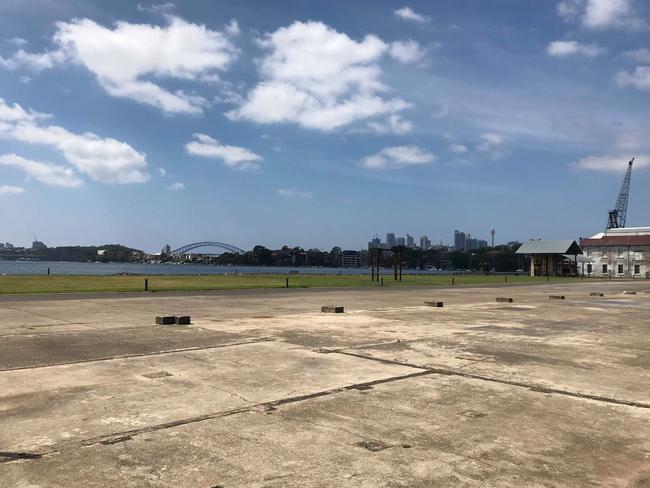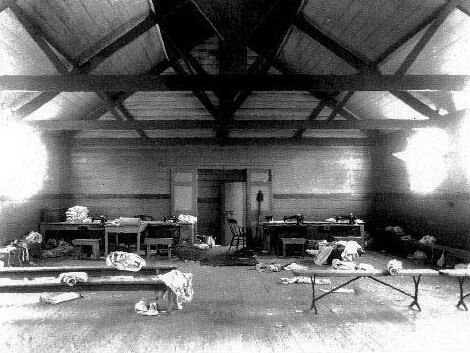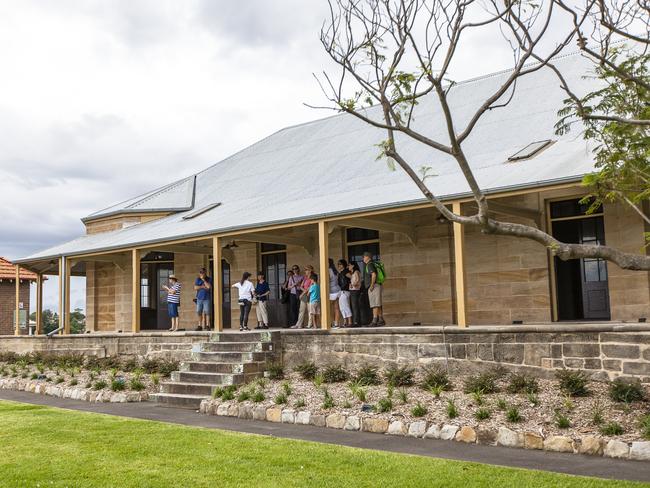The gruesome history of Cockatoo Island, one of Australia’s most haunted spots
It’s said to be among the most haunted spots in Australia. But the most upsetting thing about this spooky island isn’t the ghosts.

A former colonial prison is a perfect place for a ghost tour.
The creepy jail cells, the tortured souls that occupied them, the macabre reasons they ended up there: it’s classic nightmare fodder.
But on a paranormal tour of Sydney’s Cockatoo Island, said to be one of the most haunted places in Australia, it wasn’t the supposed ghosts of hardened criminals that was most unsettling.
A stone’s throw from the waterfront mansions lining Sydney Harbour, Cockatoo Island — a UNESCO World Heritage Site — has a grim and varied history.
It was a brutal colonial prison — like an Australian Alcatraz — between 1839 and 1869, where numerous prisoners died in custody and others died trying to flee. One famous story involves a guard being murdered by an inmate.


After 1900 it became a crucial shipbuilding yard and naval dockyard, where conditions were better, but tough. Workers were killed in gruesome industrial accidents and at least one person mysteriously vanished.
These days Cockatoo Island, overseen by Sydney Harbour Federation Trust, is a popular music and arts venue and daytrip spot. But tourists and even staff have reported various kinds of paranormal activity on the island, which draws ghost hunters from around the world.
And while the grisly stories — and alleged ghosts — from the prison and dockyard eras are frightful stuff, they don’t seem to leave visitors as unsettled as those from a third bleak chapter in Cockatoo Island’s past: when it was home to a brutal reformatory school for little girls, some of whom are said to have never left.


On a recent Saturday night after dark, a crowd of visitors gathered under the island’s imposing sandstone cliff for the paranormal tour, held once a week.
After handing out EMF readers to measure electromagnetic flux, the tour guide explained there were five kinds of hauntings, and they’d all been reported on Cockatoo Island.
These were dark shapes, intelligent hauntings (such as interactions with an entity), residual hauntings (when activity from a traumatic event is “trapped” and replays on a loop), electronic malfunctions (we were warned our phone batteries might drain unusually quickly — that’d be the ghosts) and the really malevolent kind: poltergeists.


One chilling story about a poltergeist haunting involved a worker being violently pushed out of a room by an unseen force in Biloela House, the old superintendent’s residence.
When the group visited Biloela House, we were told we might feel like someone was blowing down our necks or a general feeling of dread — or actually see an apparition.
During another part of the tour, we were told to look at a certain upper-storey window where the face of the building’s unfortunate former resident sometimes appeared. Inside that building, previous visitors had smelled unexplained wafts of tobacco smoke and heard footsteps on the empty staircase.


Elsewhere, as we passed a women’s public toilet, the guide said a Cockatoo Island worker went out of her way to avoid it, terrified by an unexplained phenomenon she’d encountered there once.
Around the corner, the guide’s pendulum - which was deployed occasionally to detect paranormal activity - swung with mighty force over a particular area of morbid significance.
An especially creepy part of the island was the convict quarters, where conditions during colonial days were barbaric. A trio of punishment cells — narrow chambers carved into solid rock and used for solitary confinement — spoke to the brutality of the time. Cruelly, they were located beneath the convict cookhouse, torturing deprived prisoners with the aromas wafting from above.
These were the same cells used to punish little girls after the convict prison closed and almost seamlessly transitioned into the Biloela Reformatory and Industrial School for Girls in 1871.


The dreaded school was a home for wayward, orphaned or Aboriginal girls between the ages of eight and 18.
The girls were locked up in dormitories and often forced to sleep on the cold hard floor with no bedding. They were refused cutlery and forced to drink water from a common trough. Girls who acted up were locked in the confinement cells for hours on end.
Just off the island had been a school ship for boys called The Vernon, where the young men enjoyed happier conditions and were trained for a variety of vocations.
Meanwhile, the girls on Cockatoo Island lived in squalid conditions, were prepared only for domestic servitude, and often subjected to cruelty and violence, including being beaten and dragged by the hair.


When English social reformers Florence and Rosamond Hill visited Sydney in 1874 they were appalled by the vastly different conditions between the two schools.
“Cockatoo Island was chosen as the new location (for the girl’s institution) but this site was really no better than the old one,” they wrote.
“The building allotted to the school had obtained a terrible notoriety as a convict gaol. The home influences essential to the wholesome training of girls, the very lack of which had brought them to the school, are impossible of attainment within the gloomy walls of a prison.”
A subsequent commission into the Biloela school uncovered such cruelty and mismanagement it was shut down in 1880.


The traumatic experiences of the girls who once lived there are said to be behind many of Cockatoo Island’s most unsettling, sometimes upsetting, paranormal experiences. Visitors have reported seeing girls in white dresses near Biloela House and sounds of sobbing and a strong sense of sadness in the former dormitories.
While news.com.au couldn’t vouch for the presence of ghosts on Cockatoo Island, the after-dark tour was spookily fascinating — and real-life tales of those who suffered on the island were just as scary as any ghost story.
Thankfully we’ve come a long way in terms of law and order, children’s rights and workplace safety — even if some chilling legacies of those dark old days are said to still go bump in the night.


Those who really want to amp up the spook factor after the 90-minute tour can camp (or glamp) overnight on Cockatoo Island. Harbour ferries run regularly to the island from Circular Quay, Darling Harbour and Barangaroo.
The writer stayed overnight and took part in the paranormal tour as a guest of Cockatoo Island.

